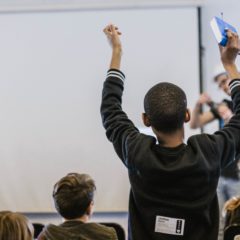As teachers, we attend countless professional development classes throughout our teaching career. I can recall attending a writing professional development class for a tool named I-Control, which I used for over a decade. I remember participating in a foldable class that provided free adult beverages-ha! In another course on character building, the creator of the course continuously discussed the great hot, delicious lunch being prepared for the attendants. There are some professional development classes that are memorable, while others you are counting down the minutes to run out to your car. The valuable pedagogy in education happens during those professional developments where I can take back what I learned to my students.

Last week, I attended a professional development that was insightful and engaging. My school district closed two high schools for one day and had the teaching staff attend the event. In an email, the staff was instructed on how to behave during the professional development; the staff knew this was serious. I attended the professional development with an open mind and returned to school with rejuvenated feelings towards teaching.
Pedagogy in Education Structure
1. The Dayton Way-I do, We do, You do! –Our district is trying to avoid state takeover. The new superintendent of my district has used the term “The Dayton Way” several times since convocation in August. “The Dayton Way” means stepping up rigor within the classroom and improving teaching pedagogies. The focus is “I do, We Do, You Do!”
During the professional development, the English Language Arts Curriculum Coordinator taught lessons on how to use “I do, We do, You do!” One lesson was focused on vocabulary. She presented the word pathos and asked for any volunteers for a definition. Afterwards, she posted the definition on the projector screen. Next, she played a video from PETA, which had everyone in awe with emotion. Finally, she asked what type of pathos was used in the video, and we discussed our answers with our neighbor.
Another lesson the curriculum coordinator taught was a writing workshop. She presented a mini lesson where she demonstrated a think aloud activity. Second, she actively engaged the participants with pictures of transportation. We had to discuss the picture with our table partners to develop a sentence that related to how to avoid an accident. Third, the facilitator suggested using ideas to use as a writing starter.
I will be using both strategies in my class!
2. Gradual Release Instruction– This practice emphasized less on direct instruction or lecturing and more on student centered lessons. The focus of the lesson is when the teacher models “I do it” and teaches through a mini lesson. Following is the guided lesson, where the teacher and students do it the lessons together. Next, students are encouraged to collaborate with a partner, so they may execute the lesson together. Afterwards, students are to do it alone. This may include homework, an assignment, or assessment. However, the last step is to be completed after students have fully understood the lesson. This practice may take one day to a week, depending on the time allowance and student understanding.
3. New Classroom Management Strategies-At some time in our career, we all struggle with classroom management. The old days of writing the names on the board with a check mark is no longer a best practice. The speaker for classroom management is currently a local high school principal, gave new suggestions on how to make teaching a little easier. The professional development began with four primary goals for classroom management: A) creating a positive climate, B) creating a community of learners, C) developing learner responsibility, and D) maximizing time and opportunity for learning.

New Rules: Classroom Management
“The person doing the speaking is the person doing the learning.” The speaker encouraged teachers to change from lecturing to teaching mini lessons and having students practice completing the assignment. This was another example of an “I do, We do, You do!” lesson and pedagogy in education.
He mentioned several tips to make your class flow smoothly:
-Greet your students at the door and show interest in them.
-During mini lessons, if someone causes a disruption, look at them in the eyes until their eyes shift.
-Moments after the disturbance, whisper to the student, “See you after class.” Then walk away.
-If a student yells out irrelevant information, deflect by saying, “Yes, I know.” Then moments later, whisper to the student, “See you after class.”
-Have a procedure for discussion. For example, if you are inviting students into a discussion, walk around. Walking around shows students you are open to questions.
If you stand at the front of the room, no questions or discussions are allowed. This is your time to teach and lecture.
The classroom management speaker gave some great tools that I was willing to use within my classroom. Try them and let me know how they worked for you.
If you have been teaching for a few years, you understand the need for professional development and details instruction in pedagogy in education. I can say this professional development event helped me keep current with the what is the new in education. Some of my teaching books are dated and do not recognize the new issue we have with competing technology within our classrooms.
Which strategy did you enjoy the most? Let me know if you used some of the strategies within your class to improve instruction in the comment section below!




Leave a Reply